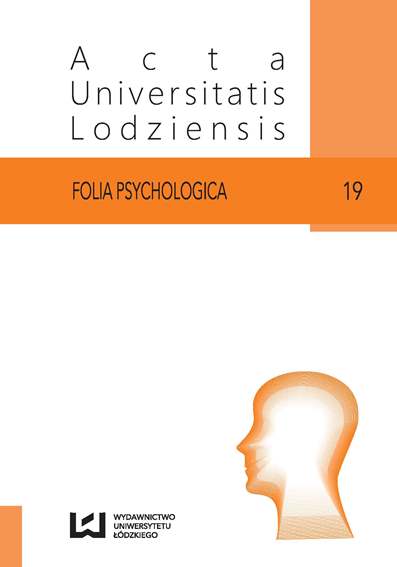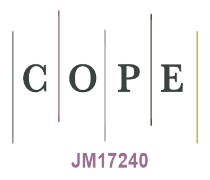The role of visual experience in mental majorization and minorization. Report on a study on blind learners
DOI:
https://doi.org/10.18778/1427-969X.19.04Keywords:
mental majorization, mental minorization, blind students, visualization, spatial imageryAbstract
It has been confirmed that the ability to visualize images, attributed to memories of visual experience, helps blind persons perform a wide range of tasks engaging spatial imagery. Two experiments involving totally blind students tested the importance of the ability to visualize images for accuracy of mental operation of enlarging or reducing the size of objects. It was hypothesized that congenitally blind persons commit a greater error than those retaining visual memory (H1) in enlarging objects (Experiment 1: mental majorization), and (H2) in reducing the size of objects imagined to be moving away (Experiment 2: mental minorization). The first hypothesis was partly confirmed. Students blind since birth showed a tendency to overestimate the size of objects which they explored manually and then mentally enlarged than those with no memories of visual experience. The second hypothesis was not confirmed – both groups made comparable mental resizing of objects imagined to be moving away.
References
Arditi A., Holtzman J. D., Kosslyn S. M. (1988). Mental imagery and sensory experience in congenital blindness. Neuropsychologia, 26, 1–12.
Google Scholar
DOI: https://doi.org/10.1016/0028-3932(88)90026-7
Brzeziński J. (1996), Metodologia badań psychologicznych. Warszawa: PWN.
Google Scholar
Cattaneo Z., Vecchi T., Cornoldi C., Mammarella I., Bonino D., Riccardi E., Pietrini P. (2008). Imagery and spatial processes in blind and visual impairment. Neuroscience and Biobehavioral Reviews, 32, 1346–1360.
Google Scholar
DOI: https://doi.org/10.1016/j.neubiorev.2008.05.002
Dulin D., Hatwell Y. (2006). The effects of visual experience and training in raised-line materials on the mental spatial imagery of blind persons. Journal of Visual Impairment and Blindness, 100, 414–424.
Google Scholar
DOI: https://doi.org/10.1177/0145482X0610000705
Francuz P., Mackiewicz R. (2005). Liczby nie wiedzą, skąd pochodzą. Lublin: Wydawnictwo KUL.
Google Scholar
Heller M. A. (2006). Picture perception and spatial cognition in visually impaired people. [W:] M. A. Heller, S. Ballesteros (red.), Touch and Blindness. Psychology and Neuroscience (s. 49–71). Mahwah: Lawrence Erlbaum Associates.
Google Scholar
Heller M. A., Brackett D. D., Scroggs E., Steffen H., Heatherly K., Salik S. (2002). Tangible pictures: Viewpoint effects and linear perspective in visually impaired people. Perception, 31, 747–769.
Google Scholar
DOI: https://doi.org/10.1068/p3253
Jagodzińska M. (2003). Rozwój pamięci w dzieciństwie. Gdańsk: Gdańskie Wydawnictwo Psychologiczne.
Google Scholar
Kennedy J. M. (1993). Drawing and the Blind: Pictures to Touch. New Haven: Yale University Press.
Google Scholar
Kennedy J. M., Juricevic I. (2003). Haptics and projection: Drawings by Tracy, a blind adult. Percetion, 32, 1059–1071.
Google Scholar
DOI: https://doi.org/10.1068/p3425
Kennedy J. M., Juricevic I. (2006). Form, projection and pictures for the blind. [W:] M. A. Heller, S. Ballesteros (red.), Touch and Blindness. Psychology and Neuroscience (s. 73–93). Mahwah: Lawrence Erlbaum Associates.
Google Scholar
Marmor G. S., Zaback L. A. (1976). Mental rotation by the blind: Does mental rotation depend on visual imagery? Journal of Experimental Psychology: Human Perception and Performance, 2, 515–521.
Google Scholar
DOI: https://doi.org/10.1037/0096-1523.2.4.515
Młodkowski J. (1998). Aktywność wizualna człowieka. Warszawa: Wydawnictwo Naukowe PWN.
Google Scholar
Smith M., Franz E. A., Joy S. M., Whitehead K. (2005). Superior performance of blind compared with sighted individuals on bimanual estimations of object size. Psychological Science, 16, 11–14.
Google Scholar
DOI: https://doi.org/10.1111/j.0956-7976.2005.00773.x
Szubielska M. (2009). The role of visual experience on the strategies of blind and sighted individuals in mental imagery. Oslo: XI European Congress of Psychology, 7–10 July.
Google Scholar
Szubielska M. (2013). Skaning, rotacja i majoryzacja figur w wyobraźni. Badania porównawcze osób niewidomych i widzących. Niepublikowany raport z badań finansowanych z grantu MNiSW (nr N N106 064235), Lublin.
Google Scholar
Szubielska M., Marek B. (2012). Comprehension of tactile graphics by school-aged children with severe visual impairment: The role of tactile perception and spatial imagery. [W:] 15th European Conference on Developmental Psychology (s. 121–130). Bologna: Medimond Publisher.
Google Scholar
Toroj M., Szubielska M. (2011). Prior visual experience, and perception and memory of shape in people with total blindness. British Journal of Visual Impairment, 29, 60–81.
Google Scholar
DOI: https://doi.org/10.1177/0264619610387554
Vanlierde A., Wanet-Defalque M.-C. (2004). Abilities and strategies of blind and sighted subjects in visuo-spatial imagery. Acta Psychologica, 116, 205–222.
Google Scholar
DOI: https://doi.org/10.1016/j.actpsy.2004.03.001
Vanlierde A., Wanet-Defalque M.-C. (2005). The role of visual experience in mental imagery. Journal of Visual Impairment and Blindness, 3, 165–178.
Google Scholar
DOI: https://doi.org/10.1177/0145482X0509900305
Downloads
Published
How to Cite
Issue
Section
License
Copyright (c) 2015 © Copyright by Magdalena Szubielska, Bogusław Marek, Łódź 2015; © Copyright for this edition by Uniwersytet Łódzki, Łódź 2015

This work is licensed under a Creative Commons Attribution-NonCommercial-NoDerivatives 4.0 International License.
Funding data
-
Ministerstwo Edukacji i Nauki
Grant numbers N N106 279339









